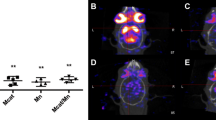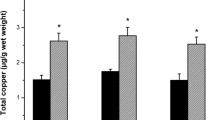Abstract
Administration of methamphetamine (METH) to animals causes loss of DA terminals in the brain. The manner by which METH causes these changes in neurotoxicity is not known. We have tested the effects of this drug in copper/zinc (CuZn)-superoxide dismutase transgenic (SOD Tg) mice, which express the human CuZnSOD gene. In nontransgenic (non-Tg) mice, acute METH administration causes significant decreases in DA and dihydroxyphenylacetic acid (DOPAC) in the striata of non-Tg mice. In contrast, there were no significant decreases in striatal DA in the SOD Tg mice. The effects of METH on DOPAC were also attenuated in SOD Tg mice. Chronic METH administration caused decreases in striatal DA and DOPAC in the non-Tg mice, but not in the SOD-Tg mice. Similar studies were carried out with 1-methyl-1,2,3,6-tetrahydropyridine (MPTP), which also causes striatal DA and DOPAC depletion. As in the case of METH, MPTP causes marked depletion of DA and DOPAC in the non-Tg mice, but not in the SOD Tg mice. These results suggest that the mechanisms of toxicity of both METH and MPTP involve superoxide radical formation.
Similar content being viewed by others
References
Adams J. D. and Odunze I. N. (1991) Biochemical mechanisms of 1-methyl-4-phenyl, 1,2,3,6-tetrahydropyridine toxicity.Biochem. Pharmacol. 41, 1099–1105.
Adams J. D., Klaidman L. K., and Leung A. C. (1993) MPP+ and MPDP+ induced oxygen radical formation with mitochondrial enzymes.Free Radic. Biol. Med. 15, 181–186.
Ali S. F., David S. N., Newport G. D., Cadet J. L., and Slikker W. Jr. (1994a) MPTP-induced oxidative stress and neurotoxicity are age-dependent: evidence from measures of reactive oxygen species and striatal dopamine levels.Synapse 18, 27–34.
Ali S. F., Newport G. D., Holson R. R., Slikker W. Jr., and Bowyer J. F. (1994b) Low environmental temperatures or pharmacologic agents that produce hypothermia decrease methamphetamine neurotoxicity in mice.Brain Res. 658, 32–38.
Ames B. N., Shigenaga M. K., and Hagen T. (1993) Oxidants, antioxidants, and the degenerative diseases of aging.Proc. Natl. Acad. Sci. USA 90, 7915–7922.
Bakhit C., Morgan M. E., Peat M. A., and Gibb J. W. (1981) Long-term effects of methamphetamine on the synthesis and metabolism of 5-hydroxytryptamine in various regions of the rat brain.Neuropharmacology 20, 1135–1140.
Burns R. S., Chieuh C. C., Markey S. P., Ebert M. H., Jacobowitz D. M., and Kopin I. J. (1983) A primate model of Parkinsonism: selective destruction of dopaminergic neurons in the pars compacta of substantia nigra byN-methyl-4-phenyl-1,2,3,6-tetrahydropyridine.Proc. Natl. Acad. Sci. USA 90, 4546–4550.
Cadet J. L. (1988) A unifying hypothesis of movement and madness: involvement of free radical in disorders of the isodendritic core.Med. Hypotheses 27, 87–94.
Cadet J. L., Przedborski S., Kostic V., Jackson-Lewis V., Carlson E., and Epstein C. J. (1990) Quantitative autoradiographic distribution of [3H]mazindol-labeled dopamine uptake sites in the brains of superoxide dismutase transgenic mice.Brain Res. Bull. 25, 187–192.
Cadet J. L., Kujirai K., Carlson E., and Epstein C. J. (1993) Autoradiographic distribution of [3H]neurotensin receptors in the brains of superoxide dismutase transgenic mice.Synapse 14, 24–33.
Cadet J. L., Sheng P., Ali S., Rothman R., Carlson E., and Epstein C. (1994) Attenuation of methamphetamine-induced neurotoxicity in copper/zinc superoxide dismutase transgenic mice.J. Neurochem. 62, 380–383.
Chan P. H., Longar S., and Fishman R. A. (1987) Protective effects of liposome-entrapped super-oxide dismutase on posttraumatic brain edema.Ann. Neurol. 21, 540–547.
Chan P. H., Chu L., Chen S. F., Carlson E. J., and Epstein C. J. (1990) Attenuation of glutamate-induced neuronal swelling and toxicity in transgenic mice overexpressing human CuZn-superoxide dismutase.Acta Neurochirurgica (Suppl.)51, 245–247.
Chan P. H., Yang G. Y., Chen S. F., Carlson E., and Epstein C. J. (1991) Cold-induced brain edema and infarction are reduced in transgenic mice over expresssing CuZn-superoxide dismutase.Ann. Neurol. 29, 482–486.
Chieuh C. C., Miyake H., and Peng M. (1993) Role of dopamine autooxidation, hydroxyl radical generation and calcium overload in underlying mechanisms involved in MPTP-induced parkinsonism.Adv. Neurol. 60, 251–258.
Cohen M. V. (1989) Free radicals in ischemic and reperfusion myocardial injury: is this the time for clinical trials?Ann. Int. Med. 111, 918–931.
Cohen G. and Heikkila R. E. (1974) The generation of hydrogen peroxide, superoxide radical and hydroxyl radical by hydroxydopamine, dialuric acid, and related cytotoxic agents.J. Biol. Chem. 249, 2447–2452.
Coyle J. T. and Puttfarcken P. (1993) Oxidative stress, glutamate, and neurodegenerative disorders.Science 262, 689–695.
Das D. K., Russell J. C., and Jones R. M. (1991) Reduction of cold injury by superoxide dismutase and catalase.Free Radic. Res. Commun. 1213, 653–662.
Dawson V. L., Dawson T. M., Bartley D. A., Uhl G. R., and Snyder S. H. (1993) Mechanisms of nitric oxide-mediated neurotoxicity in primary brain cultures.J. Neurosci. 13, 2651–2661.
Deng H. X., Hentati J. A., Tainer Z., Iqbal A., Cayabyab W. Y., Hung W. Y., Getzoff E. D., Hu P., Herzfeldt B., Roos R. P., Warner C., Deng G., Soriano E., Smyth C., Parge H. E., Ahmed A., Roses A. D., Hallewell R. A., Pericak Vance M. A., and Siddique T. (1993) Amyotrophic lateral sclerosis and structural defects CuZn superoxide dismutase.Science 261, 1047.
De Vito M. J. and Wagner G. C. (1989) Methamphetamine-induced neuronal damage: a possible role for free radicals.Neuropharmacology 28, 1145–1150.
Epstein C. J., Avraham K. B., Lovett M., Smith S., Elroy-Stein O., Rottman Bry C., and Groner Y. (1987) Transgenic mice with increased CuZn-superoxide dismutase activity: animal model of dosage effects in Down syndrome.Proc. Natl. Acad. Sci. USA 84, 8044–8088.
Cibb J. W. and Kogan F. G. (1979) Influence of dopamine synthesis on methamphetamine-induced changes in striatal and adrenal tyrosine hydroxylase.Naunyn-Schmeideberg’s Arch. Pharmacol. 310, 185–187.
Hall E. D. and Braughler J. M. (1989) Central nervous system trauma and stroke. II. Physiological and pharmacological evidence for involvement of oxygen radicals and lipid peroxidation.Free Radic. Biol. Med. 6, 303–313.
Hasegawa E., Takeshige K., Oishi T., Murai Y., and Minakami S. (1990) 1-methyl-4-phenylpyridinium (MPP+) induced NADH-dependent superoxide formation and enhances NADH-dependent lipid peroxidation formation in bovine heart submitochondrial particles.Biochem. Biophys. Res. Commun. 170, 1049–1055.
Heikkila R. E., Manzino L., Cabbat F. S., and Duvoisin R. C. (1984) Protection against the dopaminergic neurotoxicity of 1-methyl-1-4-phenyl-1,2,3,6-tetrahydropyridine by monoamine oxidase inhibitors.Nature 311, 367–369.
Heikkila R. E., Nicklas W. J., Vays I., and Duvoisin R. C. (1985) Dopaminergic toxicity of rotenone and the MPP ion after their stereotaxic admin-istration to rats: implication for the mechanisms of MPTP toxicity.Neurosci. Lett. 62, 389–394.
Hirsch J. R., Helfaer M. A., Haun S. E., Koehler R. C., and Traystman R. (1992) Polyethyene glycol-conjugated superoxide dismutase improved recovery of postischemic hypercapnic cerebral blood flow in piglets.Pediatr. Res. 34, 530–537.
Jackson R. M., Veal C. P., Beckman J. S., and Bramen A. L. (1990) Polyethylene glycol-conjugated superoxide dismutase in unilateral lung injury due to reexpansion (re-oxygenation).Am. J. Med. Sci. 300, 22–28.
Johannessen J. N. (1991) A model of chronic neurotoxicity: long-term retention of the neurotoxin 1-methyl-4-phenylpyridinium (MPP+) within catecholaminergic neurons.Neurotoxicology 12, 285–302.
Johannessen J. N., Adams J. D., Schuller H. M., Bacon J. P., and Markey S. P. (1986) 1-methyl-4-phenylpyridine (MPP+) induces oxidative stress in the rodent.Life Sci. 38, 743–749.
Klaidman L. K., Adams J. D. Jr., Leung A. C., Kim S. S., and Cadenas E. (1993) Redox cycling of MPP+: evidence for a new mechanism involving hydride transfer with xanthine oxidase, aldehyde dehydrogenase, and lipoamine dehydrogenase.Free Radic. Biol. Med. 15, 169–179.
Kogan F. J., Nichols W. K., and Gibb J. W. (1976) Influence of methamphetamine on nigral and striatal hydroxylase activity and striatal dopamine levels.Eur. J. Pharmacol. 36, 363–371.
Kovachich G. B., Aronson C. E., and Brunswick D. J. (1989) Effects of high-dose methamphetamine administration on serotonin uptake sites in rat brain measured using [3H]cyanoimipramine autoradiography.Brain Res. 505, 123–129.
Kujirai K., Carlson E., Epstein C. J., and Cadet J. L. (1994) Autoradiographic distribution of μ opioid receptors in the brains of superoxide dismutasetransgenic (SOD-Tg) mice.Synapse 17, 76–89.
Lafon-Cazal M., Pietri S., Culcasi M., and Bockaert J. (1993) NMDA-dependent superoxide production and neurotoxicity.Nature 364, 535–537.
Langston J. W., Ballard P., and Irwin I. (1983) Chronic parkinsonism in humans due to a product of meperidine analog synthesis.Science 219, 979,980.
Marek G. J., Vosmer G., and Seiden L. S. (1990) Dopamine uptake inhibitors block long-term neurotoxic effects of methamphetamine upon dopaminergic neurons.Brain Res. 513, 274–279.
Moncada S., Palmer R. M. J., and Higgs E. A. (1991) Nitric oxide: physiology, pathophysiology, and pharmacology.Pharm. Rev. 43, 109–143.
Przedborski S., Kostic V., Jackson-Lewis V., Naini A. B., Simonetti S., Fahn S., Carlson E., Epstein C. J., and Cadet J. L. (1992) Transgenic mice with increased Cu/Zn-superoxide dismutase activity are resistant to 1-methyl-4-phenyl-1,2,3,6-tetrahydropyridine-induced neurotoxicity.J. Neurosci. 12, 1658–1667.
Ricaurte G. A., Schuster C. R., and Seiden L. S. (1980) Long-term effects of repeated methamphetamine administration on dopamine and serotonin neurons in the rat brain: a regional study.Brain Res. 193, 151–163.
Rosen D. R., Siddique T., Patterson D., Figlwicz D. A., Sapp P., Hentati A., Donaldson D., Goto I., O’Regan J. P., Deng H.-X., Rahmani Z. M., Krizus A., McKenna-Yasek D., Cayabyab A., Gaston S. M., Berger R., Tanzi R. E., Halperin J., Herzfeldt B., Van den Bergh T., Hung W.-Y., Bird T., Deng G., Mulder D. W., Smyth C., Laing N. G., Soriano E., Pericak-Vance M. A., Haines J., Rouleau G. A., Gusella J. G., Horvitz H. R., and Brown, R. H. Jr. (1993) Mutations in Cu/Zn superoxide dismutase gene are associated with familial amyotrophic lateral sclerosis.Nature 362, 59–62.
Schmidt C. J., Ritter J. K., Sonsalla P. K., Hansson G. R., and Gibb J. W. (1985) Role of dopamine in the neurotoxic effects of methamphetamine.J. Pharmacol. Exp. Ther. 233, 539–544.
Schotcher K. P., Irwin I., DeLanney L. E., Langston J. W., and DiMonte D. (1990) Effects of 1-methyl-4-phenyl-1,2,3,6-tetrahydropyridine and 1-methyl-4-phenylpyridinium ion on ATP levels of mouse brain synaptosome.J. Neurochem. 54, 1295–1301.
Seiden L. S. and Vosmer G. (1984) Formation of 6-hydroxydopamine in caudate nucleus of the rat brain after a single large dose of methylamphetamine.Pharmacol. Biochem. Behav. 21, 29–31.
Seiden L. S., Fischman M. W., and Schuster C. R. (1975) Long-term methamphetamine-induced changes in brain catecholamines in tolerant rhesus monkeys.Drug Alcohol Depend. 1, 215–219.
Sonsalla P. K., Nicklas W. J., and Heikkila R. E. (1989) Role for excitatory amino acids in methamphetamine-induced dopaminergic toxicity.Science 243, 398–400.
Warner H. B. (1994) Superoxide dismutase, aging, and degenerative disease.Free Radic. Biol. Med. 17, 249–258.
Author information
Authors and Affiliations
Rights and permissions
About this article
Cite this article
Cadet, J.L., Ali, S.F., Rothman, R.B. et al. Neurotoxicity, drugs of abuse, and the CuZn-superoxide dismutase transgenic mice. Mol Neurobiol 11, 155–163 (1995). https://doi.org/10.1007/BF02740692
Issue Date:
DOI: https://doi.org/10.1007/BF02740692




